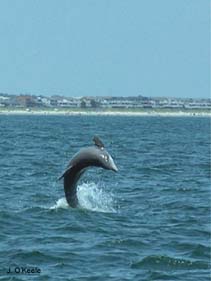Tursiops truncatus (Montagu, 1821)
Bottlenose dolphin| Native range | All suitable habitat | Point map | Year 2050 |

|
| This map was computer-generated and has not yet been reviewed. |
| Tursiops truncatus AquaMaps Data sources: GBIF OBIS |
Classification / Names Populärnamn | synonymer | CoL | ITIS | WoRMS
Mammalia | Cetartiodactyla | Delphinidae
Environment: milieu / climate zone / djupintervall / distribution range Ekologi
Pelagiska; havsvandrande (Ref. 75906); djupintervall 0 - 1316 m (Ref. 116169). Subtropical
Distribution Länder | FAO områden | Ekosystem | Förekomster | Utplanteringar
096675 Tursiops truncatus ponticus Endemic to Black Sea.
Length at first maturity / Size / Weight / Age
Könsmognad: Lm ?, range 240 - 260 cm Max length : 380 cm TL hane/ej könsbestämd; (Ref. 1394); publicerad maxvikt: 650.0 kg (Ref. 1394)
Short description Morfologi
Life cycle and mating behavior Könsmognad | Reproduktion | Lek | Eggs | Fecundity | Larvae
Main reference
referenser | Koordinator | Medarbetare
Tan, J.M.L. 1995 A Field Guide to the Whales and Dolphins in the Philippines. Makati City: Bookmark. 125 p. (Ref. 936)
IUCN Red List Status
(Ref. 130435: Version 2025-1)
CITES status (Ref. 108899)
CMS (Ref. 116361)
Threat to humans
Human uses
Fiskeri: kommersiell; bete: usually
FAO - fiskeri: landings, species profile | FishSource | Sea Around Us
Verktyg
Ytterligare information
Max. ages / sizes
Length-weight rel.
Length-length rel.
Length-frequencies
Mass conversion
Abundans
Internet-källor
BHL | BOLD Systems | CISTI | DiscoverLife | FAO(fiskeri: species profile; publication : search) | Fishipedia | GenBank (genome, nucleotide) | GloBI | Gomexsi | Google Books | Google Scholar | Google | PubMed | Tree of Life | Wikipedia (Go, sök) | Zoological Record



